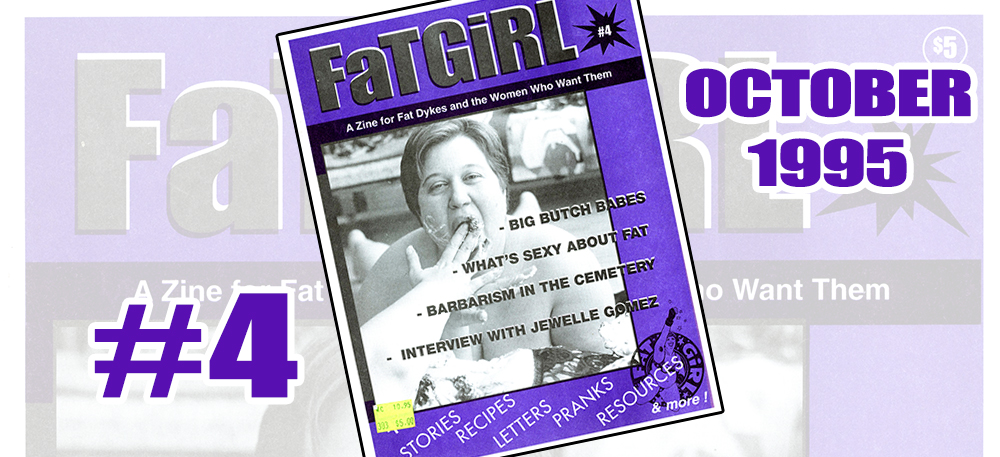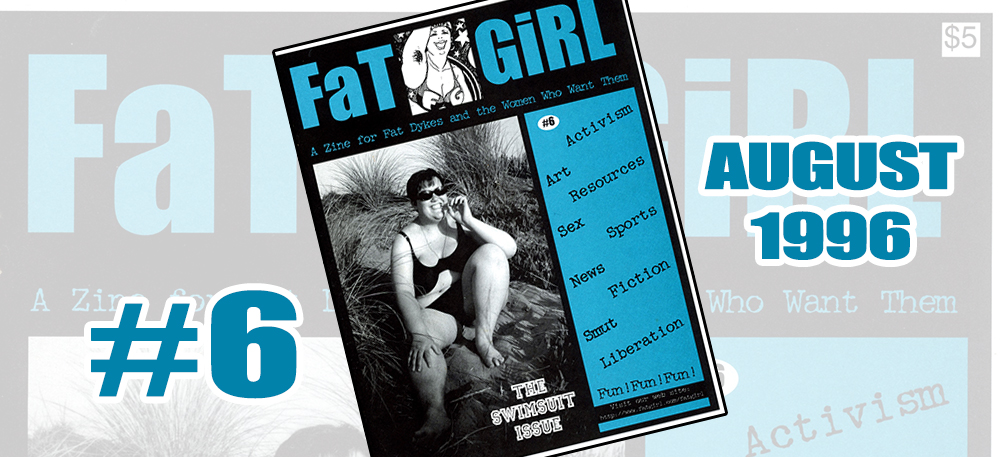Title (as given to the record by the creator): Fat & Healthy
Date(s) of creation: October, 1995
Creator / author / publisher: Lori Selke, FaT GiRL
Physical description: Two zine pages with text and an image of the inside of a leg.
Reference #: FG4-024-025-FatAndHealthy
Links: [ PDF ]
Fat & Healthy
by Lori Selke
Many fat girls experience pain in their knees sooner or later. They’re certainly not alone. The knee is the most commonly injured joint in the body. This is partly because the knee is probably the most complex joint in the body, too, providing lots of places to injure.
There are two main types of knee injuries, acute injuries (like when you tear a tendon or pull a muscle, usually as a result of some immediate trauma), and overuse injuries. Fat girls will most often suffer overuse injuries; for us, just walking is sometimes enough. Because of the increased weight-bearing load we provide our knees, many fat girls will experience sports medicine injuries just from being normally, healthily active, fat girl athletes and those of us who are more active than average are even more prone to overuse injuries of the knee.
There are some other risk factors for overuse knee injuries as well. If the muscles on one side of the knee are noticeably stronger than the muscles on the other side, the kneecap can end up being pulled awkwardly. It’s fairly common for the front muscles of the thigh, the quadriceps, to be stronger and looser than the muscles in the back of the thigh and knee, the hamstrings. Sometimes, the supporting muscles to the left and the right of the knee are unequal in strength, too. There are also some fairly common anatomical abnormalities that can predispose someone to knee pain and injury; knock knees, flat feet, and bowed legs are three examples. Theoretically, women are more prone to knee injuries as well because women’s wider hips create possible knee instability. Whether this is true in practice, however, isn’t well-documented.
When you go to a doctor with pain around the kneecap, the diagnosis you’re most likely to receive is that of patellofemoral pain syndrome. This diagnosis, unfortunately, doesn’t mean much more than “unexplained pain in the knee.” If you didn’t injure it in any way you can remember, and there isn’t any inflammation anywhere, this is the most likely diagnosis.
Another common overuse injury is tendinitis, which is an inflammation of one of the tendons around the kneecap. This is often accompanied by a swelling around the area and tenderness at a specific spot.
A third, fairly common overuse injury is bursitis, which means that one of the fluid sacs, or bursae, that cushion some of the structures of the knee is inflamed. Again, often there is swelling and/or tenderness in a localized area.
A more serious condition is osteoarthritis. This is the most common form of arthritis, and it means that the cartilage at the ends of the bones in the joint have been damaged. The symptoms of osteoarthritis include fairly constant aching, soreness, and a grinding sensation when the joint is used. Inflammation will also often accompany these symptoms. Often, osteoarthritis will affect old injury sites or joints that have been repeatedly injured. Fat girls often get arthritis of the knee at a relatively early age, by the way, especially if they have a history of knee problems.
Unfortunately, knee pain is one of those ailments that doctors most often advocate weight loss to treat. It’s true that the less weight brought to bear on a bad joint, the less likely it is that that joint will be (re)injured in the future. But there are other ways to cope with knee pain.
For milder knee pain such as patellofemoral pain, bursitis, and tendinitis, ice, elevation, rest and anti-inflammatory drugs such as ibuprofen, naproxen, or acetaminophen can help a lot in the short run. Often, this is all that doctors prescribe (other than that suggestion about losing weight).
For severe or long-standing knee pain of any type, surgery is sometimes recommended. A discussion of the various surgeries, their procedures, recovery afterwards, etc., is outside of the scope of this column, however. One note: there is some evidence that knee replacement surgery, which is sometimes recommended in certain cases of osteoarthritis, may not be as successful with fat girls as it is with other patients. It’s also possible that artificial replacement knees may wear out faster in larger women than in others.
Longer-term treatment and prevention of overuse knee problems is probably also a good idea. There are lots of things besides losing weight that fat girls can do to lessen the chance of overuse injuries in the future.
The first is, buy and wear good shoes, especially if you’re exercising regularly, though it’s a good idea even if you’re not. If you have high arches (like I do), this is even more important. Find a pair of athletic-style shoes that provide good arch support, feel comfortable and supportive (not too loose or roomy), and make them your daily wear shoes, if you can. Sometimes, a doctor can help describe the kind of shoes you should look for; the shoe store sales staff may also be able to help.
One thing to consider, especially if you’re a runner: the average running shoe isn’t usually designed for runners weighing over 180 lbs.; they don’t compensate for the increased impact per step. So you may have to ask around for shoes designed for heavier runners. Another possibility is to buy sorbothane insoles for your daily-wear shoes so as to increase shock absorbency, whether or not you’re a runner or athlete.
Sometimes, investing in a set of orthotics is also a good idea, especially if for some reason you’re not willing or able to wear athletic shoes daily. Orthotics are shoe inserts designed to compensate for some of the anatomical irregularities that contribute to knee pain and injury, such as flat feet, high arches, or knock knees. Some orthotics are available over the counter from makers such as Dr. Scholl’s and can be found in just about any drugstore. These are good for mild pain and anatomical conditions, and they’re also much less expensive than prescription orthotics. Prescription orthotics are custom-made for your foot and are used in more severe cases. Unfortunately, they cost a lot, but they are often covered by medical insurance, if you have it. If you have foot pain as well as knee pain, or if you wear shoes that aren’t otherwise very good for your feet, orthotics are probably something to seriously consider.
Finally, an important tool for the prevention of knee overuse injuries is exercise. There are a large variety of exercises to strengthen and balance the muscles around the knee; far too many to list and describe here. A good book on physical fitness and weight training should have a good section on such exercises. Another place to look is in a book on sports medicine; the one I recommend and use is The Sports Medicine Bible, by Lyle J. Micheli, M.D. (HarperCollins, 1995, ISBN 0-06-273143-2)
Some exercises, called isometrics, involve simply tensing and relaxing various muscles in your calf and thigh and around your knee, or pointing your toe up or forward, holding, and repeating. These exercises have the advantage of convenience; they can be performed just about anywhere: on your morning or evening commute, while you’re sitting at a desk at work or at home, while you’re eating dinner at the dinner table. They also have the disadvantage of being very boring, in many people’s minds. Still, if you don’t otherwise feel you have time to start an exercise and stretching regimen, exploring isometrics may be a good idea. Again, a good book on physical fitness should mention them; doctors also often recommend them to help rehabilitate knee injuries, and they will often have handouts and references available at the office or clinic.
For osteoarthritis, capsaicin creams, such as Zostrix cream, are sometimes prescribed. I’m told that these creams can be very valuable; they provide a gentle warming sensation to the joints and soothe inflammation. Capsaicin is derived from cayenne peppers, by the way, so cayenne poultices are a good alternative remedy. In fact, cayenne poultices can be used effectively on just about any inflamed joint condition; consult any good herbal remedy book for details on how to prepare a poultice.
As far as alternatives to traditional Western medicine go, acupressure is the most noteworthy technique for dealing with knee injury and pain; it’s especially useful for immediate pain relief, at least in my experience. Acupressure techniques are fairly easy to learn. A book such as Body Reflexology, by Mildred Carter (Parker Publishing Co., 1983), will tell you more than you ever need to know; some books on alternative therapies in general, such as The Natural Remedy Book for Women, by Diane Stein (Crossing Press, 1992, ISBN 0-89594-525-8), will often also have shorter sections on how to perform acupressure on yourself. (Books such as Diane Stein’s can be a bit new-agey to some people’s tastes (I know she’s at the limit of what I can take, for example), so be warned.) Or, you can seek an acupressure professional (such as a massage therapist), or else a friend who’s been trained or who taught themselves. In any case, acupressure should never be performed on swollen tissue, so if a part of your knee is swollen near a pressure point, it might be best to wait until you’ve healed a bit further. Nonetheless, acupressure is one of the most effective pain-relief tools this columnist has ever encountered; I recommend it highly. In addition to pain relief, it can also loosen over-tense muscles, making it much easier to walk normally and without strain again.
Unfortunately, our weight does put us at greater risk for experiencing knee injuries and pain at some point in our lives. (Your intrepid columnist, alas, knows this all too well; she learned what she knows about knees from many trips to the doctor and many more attempts at self-treatment.) But don’t let knee pain stop you from being a healthy, active fat girl. As you can see, there are lots of other risk factors to take into consideration as well, and lots of preventative and treatment strategies we can draw upon, too. Take advantage of them!
[image description: a medical drawing of a human leg from mid thigh down to toes, showing two versions: one shows just the bones, the other shows the skin cut away to reveal the muscles, veins and connective tissue.]
FaT GiRL #4 Pages
- FaT GiRL #4 Cover
- Comic: Fat Dyke Action
- FaT GiRL #4 is…
- Letters
- Editorial (Happy Birthday!)
- The Sa/Me Debate
- Joanne
- You Are Cordially Invited to Join The Kitchen Slut for Dessert
- Wet Hibiscus
- Outrageous or Courageous?
- Southern Hospitality…and Northern Exposure
- You’re Crazy, Your Life’s Outta Control, & You Should Go To Weight Watchers
- Review: Martha Moody
- A Fat, Vulgar, Angry Slut
- Fat & Healthy
- Poetry: arms bigger than, first date
- Story: Arrival
- Potty Training
- Confessions of a Fat Sex Worker
- Laura Antoniou’s Some Women: a brief report of my favorite essay
- Comic: True Tales from Life in the Fat Lane, Part II: The Family
- The Fat Lady Emerges and Takes Aim
- Report from the Front
- Survey: What do you want from your non-fat allies?
- FaT GiRL Roundtable: Class/Conscious
- Bo & Chrystos
- Poetry: Goddess
- Poetry: Touch Mirror
- Advice: Ask the Gear Queen
- Stories: Washing Up
- Barbarism in the Cemetery
- Survey: What’s Sexy About Fat Women?
- Write On: the lip service update
- Fat Watch
- Photography: Lanetta
- Resources
- Cuntributors
- Personals
- Back Cover FaT GiRL #4




